Facebook was out in force with a big presence at the Electronic Entertainment Expo (E3), the big game trade show in Los Angeles. E3 usually has about a billion impressions up for grabs as global gamers tune into the events, and as a social media platform, Facebook wants its share of those impressions.
The company had live broadcasts from the booth, and I participated in one of them (the last segment on this link). Facebook says that more than 700 million people tune into gaming groups, watch gaming videos, or play games on Facebook every month. And during the thick of E3 itself, Facebook said on June 11 that 18 million people were talking about E3 and the games announced there more than 65 million times. 41% of the people talking about the show were women.
At E3, I met with Leo Olebe, global director of games partnerships at Facebook, and Franco De Cesare, director of the console and online gaming at Facebook. We talked about things like Facebook’s E3 activities and how to deal with toxic gamers.
They talked about rolling out in March a dedicated Facebook Gaming tab for people to find all of their favorite gaming content in one place, personalized for them. And Facebook is investing heavily in its gaming creator programs (for people like livestreamers or professional gamers) so that they can earn a living from livestreaming games on Facebook.
June 5th: The AI Audit in NYC
Join us next week in NYC to engage with top executive leaders, delving into strategies for auditing AI models to ensure fairness, optimal performance, and ethical compliance across diverse organizations. Secure your attendance for this exclusive invite-only event.
Last year, the company announced its Level Up program for aspiring gaming creators to build their livestreaming communities on Facebook, and it is now available in more than 40 countries. More than 50 of partnered Facebook Gaming creators have come from the Level Up program. And one-third of the Level Up creators say the program was the first experience they had with livestreaming.
Meanwhile, Facebook also announced that playable ads are now available on the Audience Network for rewarded video and interstitial placements along with new gaming monetization features for advertisers. Lastly, the company continued to support women in gaming at E3, and it announced two new Global Gaming Citizens.
Together with The Game Awards at E3 Coliseum, Facebook drew attention to Vanessa Gill of Social Cipher and Damon Packwood of Gameheads. Social Cipher is a story-driven video game that gives children with autism a safe, fun, and accessible space to apply social skills. And Gameheads, based in Oakland, is a youth non-profit training low-income and first-generation students ages 15–24 in video game design and development to prepare them for careers in the entertainment and tech industries. (A previous Global Gaming Citizen, Lual Mayen, launched a Kickstarter campaign for his game about peace, Salaam).
Here’s an edited transcript of our interview.
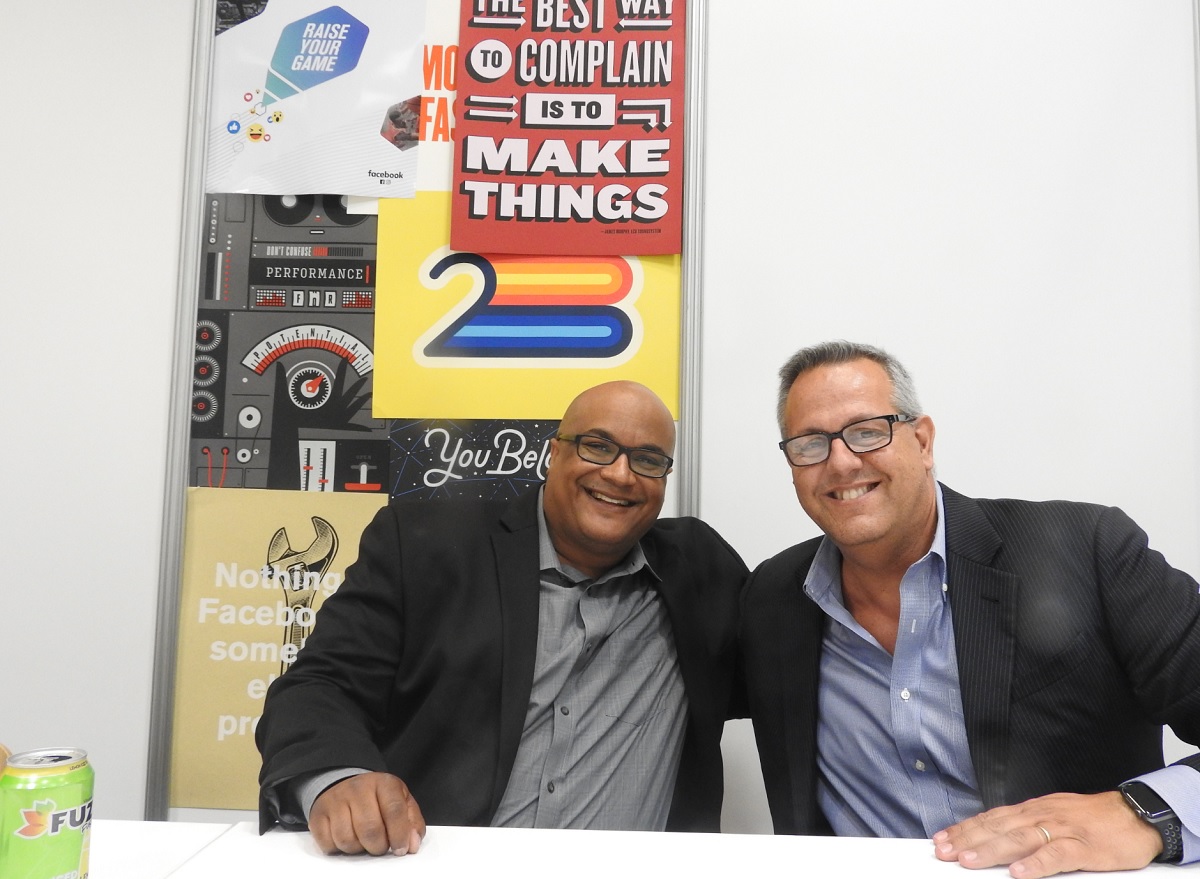
Above: Leo Olebe and Franco DeCesare of Facebook games at our 2018 interview.
Leo Olebe: In March we released the game tab. That’s important, because it’s the first time we’ve collected a lot of the different parts that we’ve been building from a gaming product standpoint over the years: Instant Games, the ability to play gaming video, the ability to watch roots content. That’s very big. Then we have creators here on stage again.
We announced two new Global Gaming Citizens just yesterday, at the Coliseum. We were on stage with Geoff and we brought back Sadia Bashir, one of last year’s Global Gaming Citizens. Then we introduced a young woman named Vanessa Gill. Vanessa has Asperger’s syndrome. She was undiagnosed for a long time, and went on to get a neuroscience degree. She created a development studio called Social Cipher. They’re building a game to help autistic kids learn how to process emotion and interact better with the world around them.
The other we announced yesterday was Damon Packwood. I don’t know if you’ve heard of Damon’s program, Gameheads out of Oakland. They work with low-income and minority youth in Oakland, teaching them coding, level design, all this stuff. He has a big partnership network with probably 200 different developers who come in every weekend and teach programs and help kids learn what the game industry is all about. They’re building amazing things. That’s been really exciting.
We even had a Women in Gaming breakfast yesterday, where we talked about allyship. We brought in several hundred women and men to have this conversation. That’s been a big part of what our E3 experience has been, just the continual push to fight toxicity, drive inclusion, and improve diversity in the game industry. Those are all big initiatives for us as well.
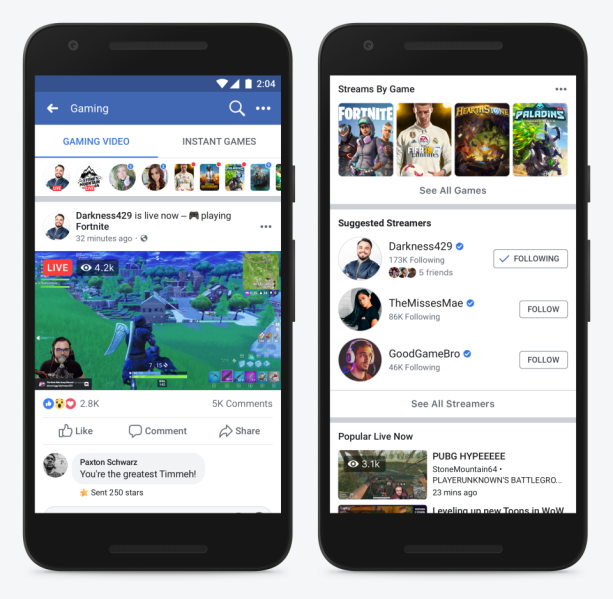
Above: Facebook gaming video
On the gaming side of things, we talked a bit about the tab. At F8 we introduced some new experiences inside of groups, where gamers can start chatting with each other both before and after gameplay to get together. It’s one thing after another that we’re working on to try and build the world’s gaming community. It’s been quite a journey.
We’re talking about some new stats with our Level Up program. We had originally announced our Level Up program as part of our Facebook Gaming Creators. I think last year at some point. It’s been growing over time. Now we’re in more than 40 countries. Probably one of the coolest things about the adventure we’re on is that — I believe about 30 percent of people that are streaming games to Facebook as part of the Level Up program have never streamed games before. It’s this idea of, is it possible to broaden the market? How does that tie into this overall narrative of, everyone’s a gamer? I think that’s the theme of the day. We’ve believed everyone is a gamer for quite some time.
That’s been good to see. They’ve been great. They’re streaming all sorts of games, all the games you would expect, and then streaming to new audiences and new countries, a really diverse population around the world. It’s more along these lines of different things we can do on the product and engineering side to improve the ways gamers can connect to their communities and the games they love.
Franco de Cesare: On the marketing partnership side with publishers, two weeks ago we published a study you might have seen, in partnership with Accenture, that communicated a lot of what we’ve been seen in terms of engagement. We looked at the path to marketing and engagement in the console and PC spaces. It reinforced some things we already knew, but it’s great to see it confirmed. One is the social nature of games, and the other is the sense of community.
There’s a whole trove of stats in that study, but just some highlights: more than 70 percent of people who play console games are doing it with family and friends. They’re way more likely to stay on and continue playing with other people. 51 percent are using Facebook and Instagram and other social platforms as key drivers of their choices as far as which games they play and which games they continue to play. It also confirms the importance of influencers. 49 percent are driven directly by seeing someone play a game. That determines what game they play, what DLC they buy.
In terms of formats, we’ve seen a lot of success with all the different innovations in formats across our different services. Again, it speaks to the breadth of the industry, the breadth of experiences around the industry, and the breadth of users and gamers of different kinds. The two most recent studies — we did a study on stories. Stories has been a great format for us in terms of engagement, with 100 billion engagements per month. We did a case study with Just Dance, released in the holidays last year, where we saw great success for them on marketing.
At the opposite side of the spectrum, for video specifically, we did a study with Resident Evil with Capcom. We have a product called Mobile Works that allows publishers to optimize their marketing assets across the board with all the different formats. With that study, they saw 2.2x improvement in reachable LTV, and that was obviously a successful release for them.
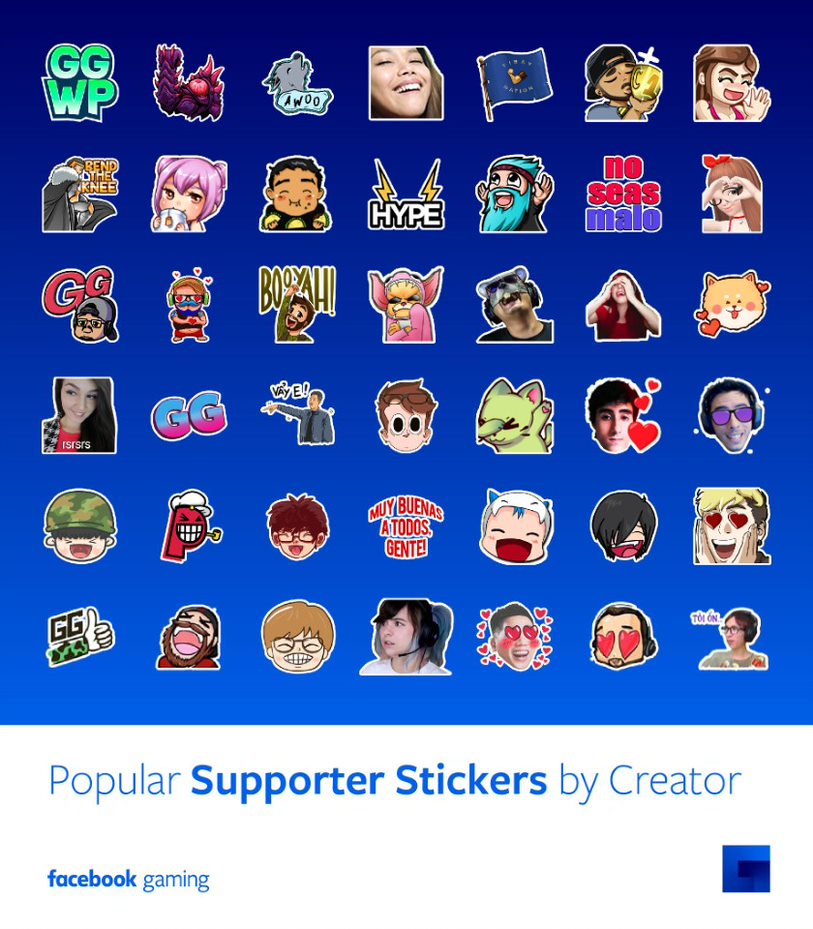
Above: Facebook emoji stickers
There’s a lot to say as a marketer about how much storytelling has evolved in this industry, how you can tell stories in different formats. Every day we find new ways to adapt to new formats in the mobile space. We haven’t published any studies about it yet, but you probably saw the goggle effect we released with Activision, the Instagram AR filter, which was kind of a labor of love between us and Activision. Obviously it’s very iconic for that game. It was an exclusive filter we developed together with them and released at the same time as the trailer. It allowed the community to engage with it. They saw really high engagement.
As usual with Activision they had a lot of celebrities involved, a lot of influencers, a lot of athletes trying it out, but really they got tremendous feedback from the community. It’s that ability to immediately play with the game that you love.
GamesBeat: On E3 yourself, how do you guys feel about the show itself, participating and running the booth? The show looks a bit thinner, both here and in the west hall. There are more small companies in the west hall. Sony is probably coming back, but I don’t know about Activision and EA. It feels like there’s a transition happening.
de Cesare: All of us have been to quite a few E3s. On our side, we have always believed, especially over the last few years, that E3 is a moment in time for the industry. It has a global reverberation. It’s not just what happens here at this location. This is the spark of what we see growing in the coverage and engagement that goes around the world digitally.
On that side, we’ve seen it continue to grow. We publish our own side of the conversation. We saw 18 million people in 10 days engage with games at E3. 65 million engagements. We can’t do a direct comparison versus last year because of the difference in the period we look at, but those are very big numbers. Even if you look at it without the apples to apples comparison, it feels like the interest around E3 and the global footprint of our digital platform is bigger than ever. Even though I’m very confident that you could argue that the number of news stories, the number of new games released at this E3 is somewhat inferior to others. It definitely was in terms of the press conference, since there’s no PlayStation.
As far as my personal view of the floor, there’s definitely a rebalancing of things in terms of the hardware hall versus the software hall. But this feels very buzzy, here in the south hall where we are. There are some very big games – Cyberpunk, Borderlands. The talk of the show is all in this hall. Nintendo is a great anchor for the other side, but with Microsoft being outside and PlayStation not being here at all, it does seem a little thin. But at the same time, it’s the end of a console generation. You’ve covered a few. We’ve done a few. That plays into it.
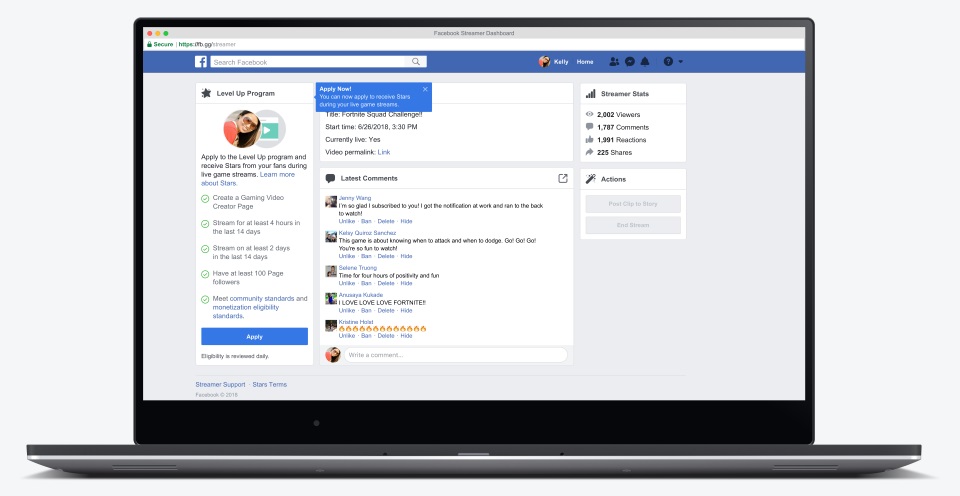
Above: Facebook Level Up program
Olebe: I would add — between the three of us here we probably have 50 E3s, 60 E3s, and however many other conventions. I think we’re in a transition moment, definitely. I think that developers and publishers are trying to figure out — let me rephrase. Developers and publishers have a much more intimate relationship with their communities. The distance between those things has been shrinking over time. If we went back into some sort of historical study, every year there would be just a bit more of those things coming closer together.
As we’ve known, the most intimate relationships in the games industry are directly between the player and the game itself. Then it’s between the player and their community. And then it’s between the community and the developer. We’re in a transition period where people are figuring that out. Does it make more sense for me to be in an industry hall with an industry presence, or do I want to get closer to the consumer?
I think it’s been a good thing, bringing more consumers in to play. It’s probably a bit of a debate we’ve been having. My first E3 was either 2000 or 2001, and the question was, we’re building all these amazing booths and experiences, and then only showing it off to the industry. How do we bring consumers into the fray? It’s more about that transition moment. If we’re smart about the question of what E3 means, we’ll be more open, more welcoming to consumers and creators.
I was just walking past where Borderlands is showing. They have a creator presence at their booth. We’re here because we want to talk about Facebook Gaming and all the ways we interact with creators, developers, and publishers. Clearly our creators and streamers are front and center. You’re seeing that from other companies as well. It’s a transition moment, but E3 is — I like how you phrase it, calling it a spark. It’s a moment in the industry for everyone to focus on their strategy, show off their new stuff, and hopefully be really thoughtful about how they interact with their communities.
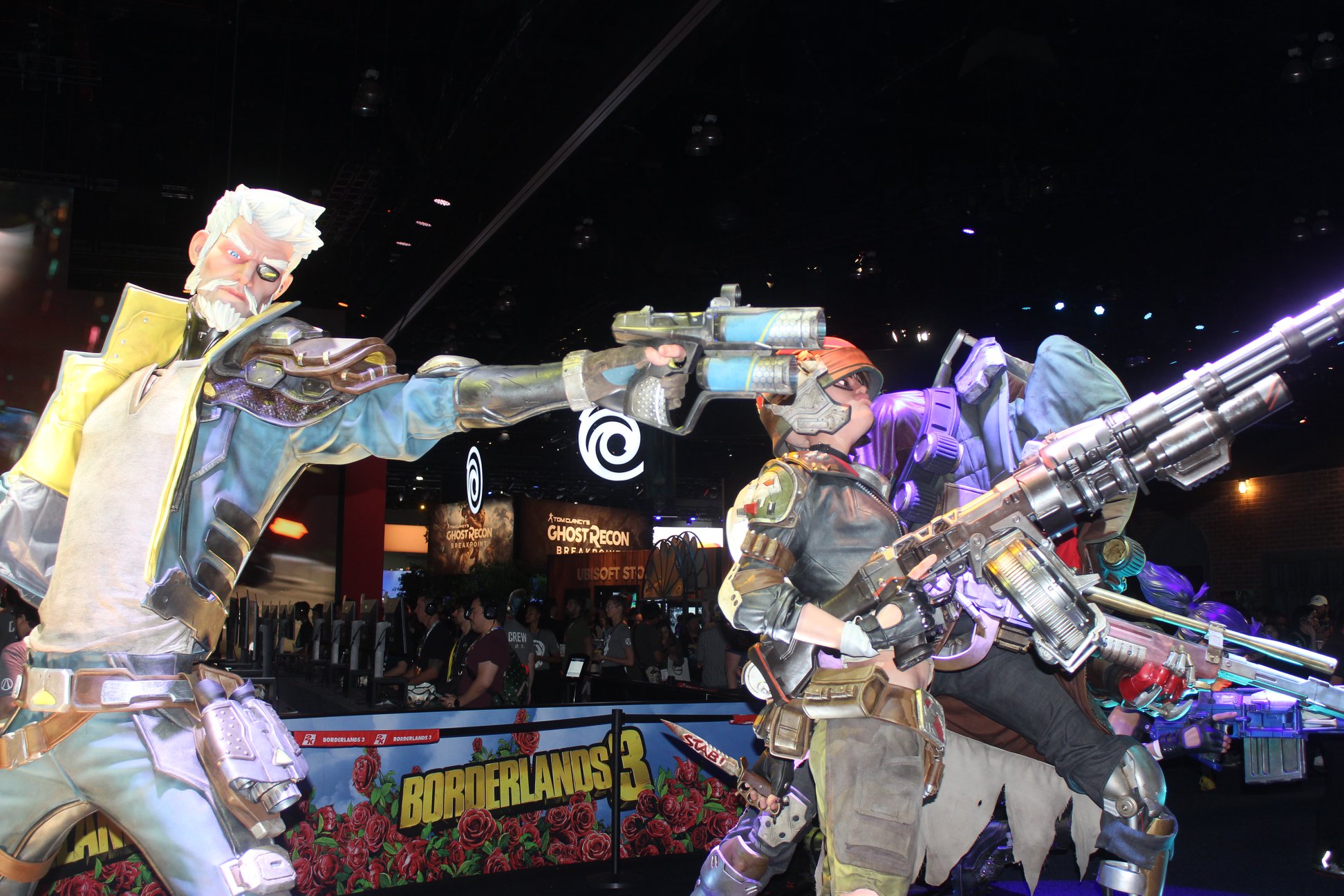
Above: Borderlands 3 booth at E3 2019.
I don’t know what E3 will look like next year, or the year after. My prediction would be more creator and influencer presence, more direct community and player presence, and more open experiences for people who are participating in the conference. It perfectly dovetails into this thing you’re saying with all the new energy around cloud gaming, all the continued energy around mobile gaming, and the idea that you should be able to play games anytime and anywhere on any device with whoever you want to and generate a community around it.
Instead of becoming more inclusive, we have to be more representative, which ties back to the first part of this conversation. It’s so important for us to bring more people into the industry, become more diverse, less toxic, and bring people together.
GamesBeat: On the toxic side, we saw a pretty good story recently on the YouTubers who were making more money because they were mean. I wonder about things that will be coming in the future. Call of Duty is sure to create a lot of buzz, good or bad. What sort of role do you think Facebook should have as far as helping to steer the community in a more positive direction?
de Cesare: Two things come to mind. I’ve followed the debate and your point of view about Call of Duty. On one side, there’s the role of the publishers and how we can help them. Publishers know more than ever now that they need to be authentic to their community. These communities see through things that are not respectful of them.
Our platform, because it has real identities and things like groups that enable that dialogue, allows them to be authentic. It doesn’t allow them to bullshit, if you’ll forgive my bad word. In that sense, our platform can help. We’re not the only one. And it’s not as if real identities mean that people with bad opinions don’t express them. We know that all too well. But it enables that authenticity.
The other part, the question of what happens when someone sees something that’s not appropriate, we work very closely with the ESRB. We believe in their mission for the industry. It’s critical that a user, a viewer, a player is always informed about content. That’s why you have the big logo at the beginning of every video. Are you sure you want to see this? But we also try — when it comes to advertising and marketing on our platform, real age and real identify have to be confirmed. That’s a filter where if it’s set up right, it can be better and more effective than a basic age gate.
The responsibility is also on the publishers to make sure that the content on their page is only viewable to certain people. When you do a campaign, when you do advertising, you have to use the ESRB. You have to reach only certain people. The 18-and-over button is very clear. They all know how to do it.

Above: Fortnite booth at E3 2019
Olebe: Everything we do is about trying to build the world’s gaming community. We’ve talked about this before. Part of that is, of course, the inherent responsibility of having the best community standards and moderation tools you can have. And the only way you’re ever going to get to the best is by listening to people and constantly improving. It’s not to say we’re perfect. There is no perfect. It’s always a question of how we can be better.
You’ve heard the phrase, “This journey is only one percent finished” probably more times than you ever wanted to. But the message is to be specific and thoughtful about building an open and positive community. Put the power in the hands of the creators and streamers to interact with their community. Encourage them to set the tone. We were on stage with Melonie Mac and GoodGameBro just yesterday. They both talked about how they have inclusive and positive communities because they work at it. They focus on driving out negative things, or at least embracing their community and the types of discussions and conversations that they want to participate in.
When toxic behavior starts to happen, there are clever ways people can intervene. Maybe it’s changing the topic. May talks about pizza. Everybody likes pizza. Let’s find some common ground. Part of the conversation is also, well, sometimes people just have a bad day and they do silly negative things. Not everybody has remorse, but some people do. People make mistakes. How do you be sure to put the power in the hands of the community itself, as well as creators and influencers, to generate an atmosphere of positivity?

Above: Call of Duty: Modern Warfare. Soldiers stack up as they enter a house.
Across the board, on our platform, that’s something we’re proud of, having lots of different diverse types of streamers and diverse populations of people who are watching streams. We’ve talked about 700 million people a month who are playing, watching, and sharing games on our platform. In aggregate, more than 40 percent of them are women. If we only focus on the Play side of that it’s much higher than that. It’s like 55 percent or more. We’re doing the best job we can. There’s always room to learn and grow, but we have to be specific, we have to be thoughtful, and we have to be open to figuring things out as we go.
GamesBeat: I had one interesting moment where I had a long off-the-record conversation with one of the YouTubers on the opposite side of Call of Duty. We came to a point where we understood each other. That was a good thing. It’s kind of rare.
Olebe: Everybody chooses how they want to interact with the world. Speaking for myself, I prefer to interact on the side of positivity, of engagement and inclusivity. Others may choose differently. But all we can ever do is encourage what we perceive to be the type of behavior we want to associate ourselves with. I’ve heard the analogy before, but there are some people who just really want to go to a dive bar and know that they’re going to get in a fight. That’s what’s exciting for them. And other people are there to interact and have a great time. There’s responsibility all around, is what I think I’m trying to say.


